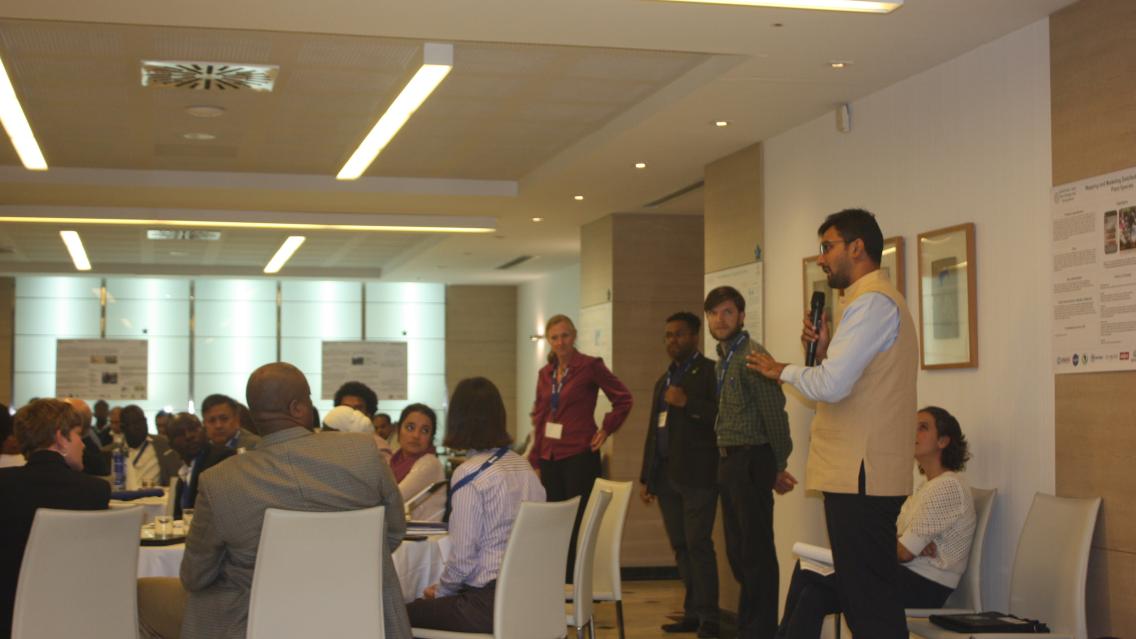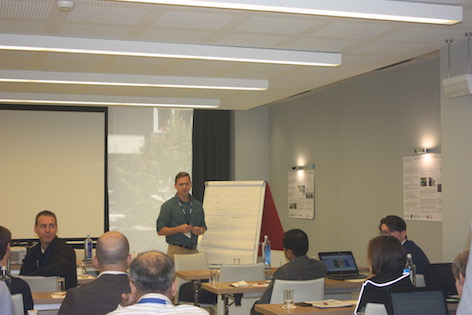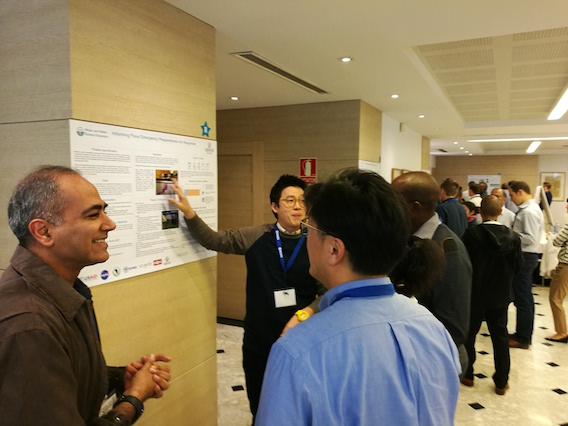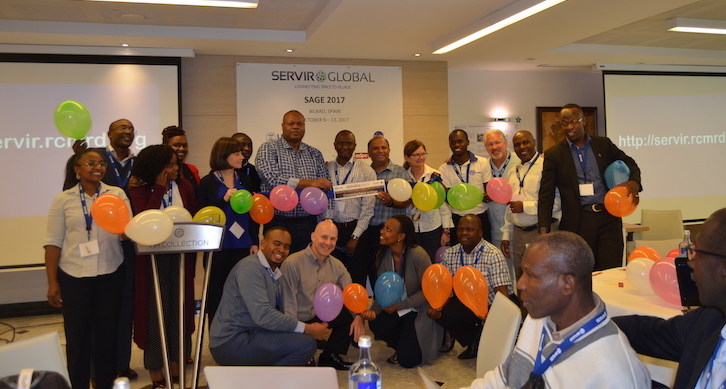3rd SERVIR Annual Global Exchange Focuses on Lasting Impact

Sharing lessons learned and deepening service planning approaches for the future
The third SERVIR Annual Global Exchange (SAGE) brought together over 110 team members from across the SERVIR network to Bilbao, Spain from October 9-13, 2017. The largest since its inception, the exchange drew participants from SERVIR hubs in Niger, Kenya, Nepal and Thailand; the SERVIR Science Coordination Office (SCO) in Huntsville, Alabama; NASA and USAID Headquarters in Washington, D.C.; USAID Missions; SERVIR Support Team; and SERVIR Applied Sciences Team (AST) members from institutions across the United States.
| Vishwas Chitale, SERVIR-HKH Remote Sensing Analyst, shares his experiences with SAGE Plenary participants |
During the exchange, participants shared and discussed lessons learned and strategies for better integrating and implementing customer-focused service planning across all SERVIR activities, while ensuring long-term impact and sustainability.

Cross-cutting Discussions
To better facilitate collaboration and dialogue among participants, the first day included sessions on regional activities involving AST, SCO and Hub scientists, evaluation of program efforts (such as capacity building, communications, knowledge management, and monitoring and evaluation), and reports under SERVIR’s four service areas: Agriculture and Food Security; Land Cover, Land Use Change and Ecosystems; Weather and Climate; and Water and Water-related Disasters. During the course of the day, AST, SCO, and hub affiliates exchanged views on past, current and upcoming initiatives.
 |
| Eric Anderson, SERVIR-Mekong Regional Science Coordination Lead, presents during a side session |

Achieving Lasting Impact
Under the theme of Achieving Lasting Impact, representatives from USAID, NASA and the SERVIR hubs made opening plenary remarks on the second day.
In particular, NASA’s Dan Irwin highlighted the importance of discussing sustainability – how the term can have different meanings depending on regions, partners and people – and shared his vision for SERVIR 2030 as, “A sustainable network of regional hubs providing impactful services – using the best and most appropriate science to address the most pressing needs of the countries and regions SERVIR supports.” As a call-to-action, USAID’s Jenny Frankel-Reed urged participants to reflect on and discuss the value SERVIR provides to stakeholders and how this value can be further leveraged to ensure long-term sustainability in a development context.
Service Planning Across All Hubs
Building on the themes of impact and sustainability, the third day focused on lessons learned from the hubs on the implementation of SERVIR’s Service Planning Approach – a multi-step program management process aimed at ensuring that SERVIR services across the network are relevant and sustainable, while ensuring customer satisfaction and buy in. This approach is implemented through four tools: Consultation & Needs Assessment; Service Design; Stakeholder Mapping; and Monitoring, Evaluation & Learning.
 |
| SAGE participants enjoy learning more about the science, outcomes and impacts of SERVIR services during a Poster Session |
A Service Planning toolkit, first conceptualized in 2015, was formally introduced during SAGE 2016 in Pokhara, Nepal. Subsequently, a four-day Service Planning Exchange in Nairobi, Kenya, in April 2017 brought the hubs together for further testing and validation of the tools and to collaborate on how these tools could be improved. Focusing on sustainability and impact, SAGE 2017 sought to deepen SERVIR’s integration of this approach by continuing discussions on overcoming challenges and sharing success stories, as well as exploring opportunities for future partnerships with academia, commercial sector, government, space agencies and other projects with a national and international focus.

Impact of Science on Communities and Regions
The fourth day showcased 30 science-themed posters presented by hubs and ASTs that exemplified the impact they have had under SERVIR’s four service areas. Connection and inspiration were evident in the gallery of innovative projects that addressed challenging issues. For instance, SERVIR-Eastern & Southern Africa co-developed with USAID’s Famine Early Warning Systems (FEWS NET) updated cropland maps which aided Kenya’s State Department of Agriculture in piloting an Agriculture Insurance System to provide payouts to farmers during incidences of crop failure. With a population of 44.2 million, 61% of Kenya’s population relies on the agriculture sector for at least part-time employment. The project’s outcome also helps to alleviate hunger, achieve food security, and promote sustainable agriculture.

Celebrating the launch of RCMRD/SERVIR-Eastern and Southern Africa's new website, http://servir.rcmrd.org
In addition, the fourth day was highlighted by the launch of SERVIR’s Eastern & Southern Africa hub new website, plus SERVIR’s new internal database which will help institutionalize the Service Planning Approach across the network of hubs.
SERVIR in the Future
 |
The exchange concluded with group discussions focusing on evolving challenges and technologies that are likely to affect SERVIR’s service areas and hubs. With the anticipated launch of the SERVIR-Amazonia hub in early 2018, SERVIR will continue to apply lessons learned, explore innovations and new technologies, and nurture new partnerships to reach its vision of sustainability and long-term impact in addressing development needs across the regions it serves.

